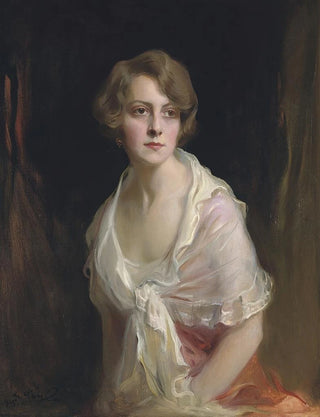Art print | Mme Claud Mullins and Gwen Brandt - Philip Alexius de László


View from behind

Frame (optional)
Philip Alexius de László's artwork "Mme Claud Mullins and Gwen Brandt" is a masterpiece that captures not only the beauty of the subjects depicted but also the essence of an era when portraiture was a privileged means of artistic expression. In this piece, the artist manages to establish a subtle dialogue between his models and the viewer, inviting the latter to explore the nuances of personality and emotions of the women portrayed. Light and shadow play a crucial role, creating an intimate atmosphere that transcends the simple frame of the portrait. Contemplating this work transports one to a world where every detail matters, and every gaze tells a story.
Style and uniqueness of the work
László's style is characterized by an impressive mastery of textures and colors. In "Mme Claud Mullins and Gwen Brandt," the models' clothing, with its refined elegance, seems almost tangible, while the faces are animated with a life that makes them appear almost alive. The painter's technique, which skillfully blends realism with a certain idealization, allows for a rare psychological depth. The expressions of the women, both serene and mysterious, invite prolonged contemplation. The composition, well-balanced, highlights the two figures while giving them a central place in the pictorial space. László succeeds in creating harmony between the subjects and the background, which is often delicate and subtle, thus enhancing the emotional dimension of the artwork.
The artist and his influence
Philip Alexius de László, of Hungarian origin, made a name for himself in the early 20th-century art world. Influenced by the great masters of portraiture, he developed a unique style that combines tradition and modernity. His portraits are often imbued with a sensitivity that reflects not only the personality of the models but also the social and cultural context of his time. László had the opportunity to work with iconic figures, which allowed him to refine his art and gain recognition beyond borders. His influence endures today, both through the quality of his works

Matte finish

View from behind

Frame (optional)
Philip Alexius de László's artwork "Mme Claud Mullins and Gwen Brandt" is a masterpiece that captures not only the beauty of the subjects depicted but also the essence of an era when portraiture was a privileged means of artistic expression. In this piece, the artist manages to establish a subtle dialogue between his models and the viewer, inviting the latter to explore the nuances of personality and emotions of the women portrayed. Light and shadow play a crucial role, creating an intimate atmosphere that transcends the simple frame of the portrait. Contemplating this work transports one to a world where every detail matters, and every gaze tells a story.
Style and uniqueness of the work
László's style is characterized by an impressive mastery of textures and colors. In "Mme Claud Mullins and Gwen Brandt," the models' clothing, with its refined elegance, seems almost tangible, while the faces are animated with a life that makes them appear almost alive. The painter's technique, which skillfully blends realism with a certain idealization, allows for a rare psychological depth. The expressions of the women, both serene and mysterious, invite prolonged contemplation. The composition, well-balanced, highlights the two figures while giving them a central place in the pictorial space. László succeeds in creating harmony between the subjects and the background, which is often delicate and subtle, thus enhancing the emotional dimension of the artwork.
The artist and his influence
Philip Alexius de László, of Hungarian origin, made a name for himself in the early 20th-century art world. Influenced by the great masters of portraiture, he developed a unique style that combines tradition and modernity. His portraits are often imbued with a sensitivity that reflects not only the personality of the models but also the social and cultural context of his time. László had the opportunity to work with iconic figures, which allowed him to refine his art and gain recognition beyond borders. His influence endures today, both through the quality of his works






